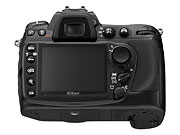Get to know Nikon's mid-range digital SLR camera better through one user's shooting torture tests.
The best way to learn a camera is to take it out in the field, pushing the camera's limits as you shoot in both familiar circumstances and unknown environments. I had the opportunity to do just that with the new Nikon D300 digital SLR recently--and came away impressed by many of the usability touches I found.

At $1799 for the body only, the D300 represents Nikon's new midrange offering, falling between the D80 and the professional-level D3. This model replaces the two-year old Nikon D200, which earned a respectable PC World rating of 80.
In developing the D300, Nikon leveraged many of the technological evolutions it included in the $5000 Nikon D3. As someone who's shot with a pro-level camera (the Canon 1D Mark II), I hate making compromises when I step down to a lower-level SLR.
While I haven't shot this extensively with the D3, I can say that when I used the D300 last week, I didn't feel as if I was making too many compromises. What follows are five aspects of the D300's design that caught my attention.


Low-light Handling: While PC World's tests have yet to be completed, in the field, the D300 seemed to do a solid job handling low-light situations. Whether I was shooting the gymnasts in a poorly lit gymnasium at Stanford University, or outside of AT&T Park at night, or inside San Francisco's iconic Ferry Building, I found the camera surprised me time and again with how it could capture an image without the flash--with what appeared to be an reasonable degree of noise and sharpness (I used a 15-year-old 50mm 1.8 lens for the gymnastics, and Nikon's 18-200mm lens with Vibration Reduction for the latter two tasks). The Auto ISO feature works in all modes, up to 3200 ISO--which means you don't have to think about what ISO is best when you're shooting.
Changing Auto-focus Points: In shooting, I found it notably simple to change the auto-focus (up to 51 on the D300, vs. 11 focus points on the D200) on-the-fly. Rather than cycling through focus points, I could instead use the multidirectional navigation pad to choose which spot I wanted the focus point. This proved a great convenience when I was shooting a mask with depth, and I wanted to both compose the image and have the focus be on a specific part of the mask.
Information Displays: I found the D300's information displays well-presented overall (as on the D200). Whether I was looking at the LCD on top of the camera, the large-type replication of that information display on the rear LCD (new to the D300: The rear LCD automatically changes color, depending upon whether it's dark or light, turns to a black background with white text for easier readability), or looking at an image's related shooting information--the pertinent info was clearly and concisely presented.
We'll know more when the camera comes out of testing and is the subject of a full PCW review. Stay tuned.
http://www.pcworld.com/article/id,141719-c,digitalcameras/article.html

No comments:
Post a Comment